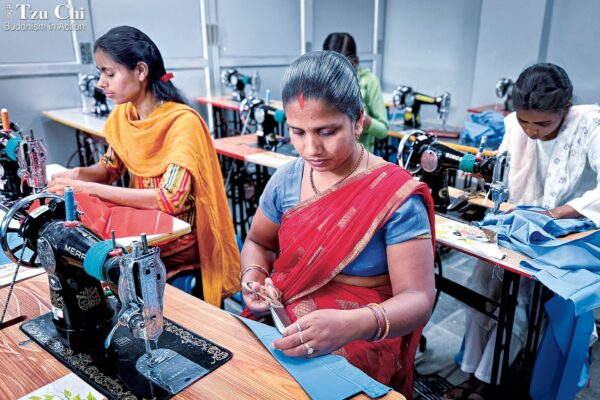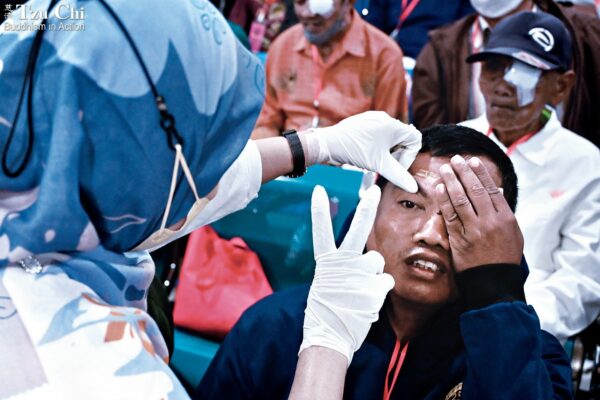By Chen Li-an
Translated by Tang Yau-yang
Photos by Hsiao Yiu-hwa
How do recycled assistive devices end up as treasures instead of junk? Volunteers disinfect, clean, repair, and sometimes spray-paint the reclaimed equipment so that the items look new and attractive again. Then they deliver the refurbished devices to the homes of people who need them and will treasure them anew.
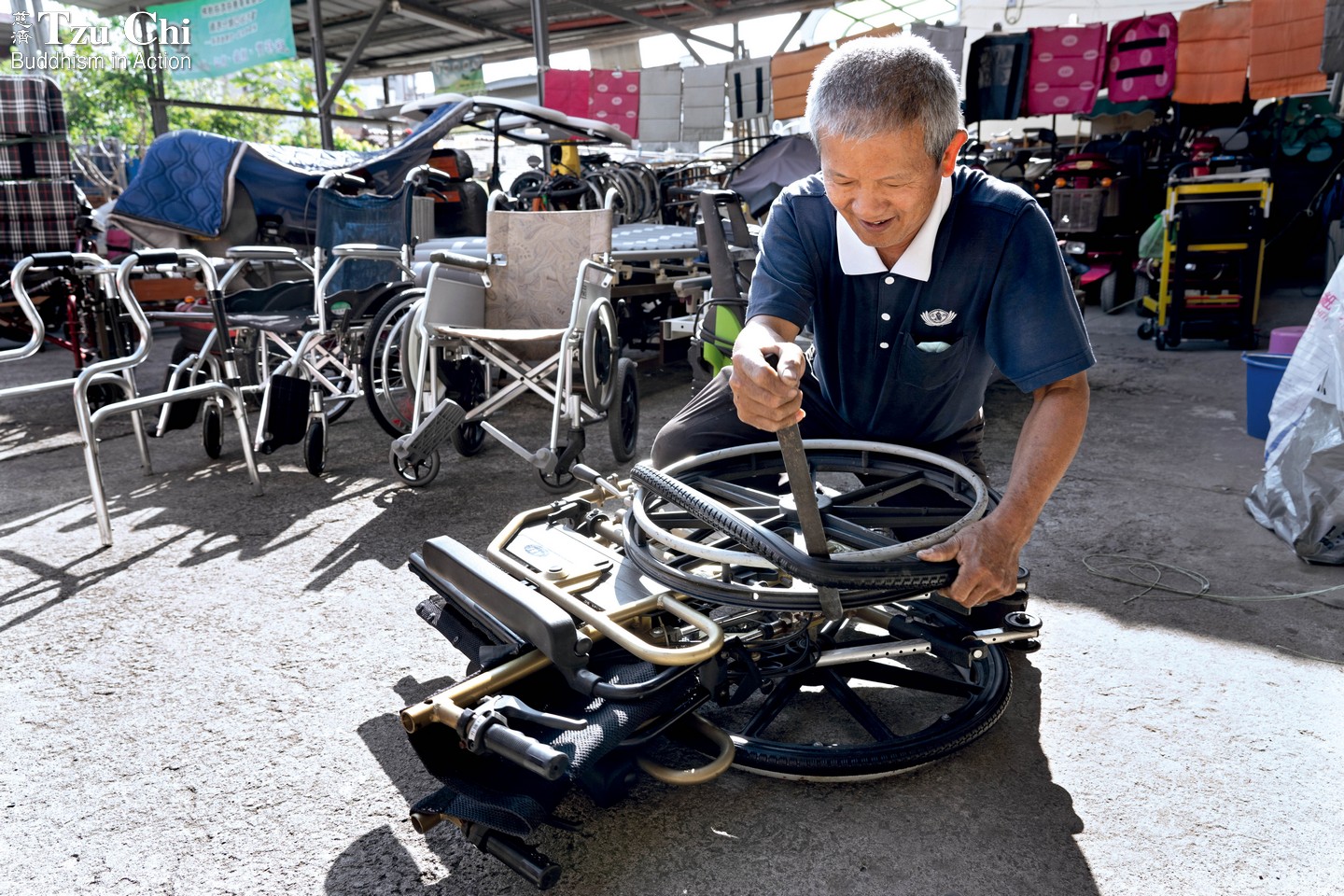
Volunteer Hong Xi-cai, of Nantou, central Taiwan, dexterously changes a tire on a wheelchair. Around him are used assistive devices provided by community residents or salvaged from recycling stations.
The discarded appliances and other kinds of equipment that end up at Tzu Chi recycling stations may be junk to most people, but they’re treasures to Tzu Chi recycling volunteers. Some items can be restored to good working order with just a little tweaking, others need more serious attention, but if an item can be refurbished, volunteers are eager to do their best to extend its life. Some volunteers have developed a special interest in restoring assistive devices. They work to lengthen the useful life of such equipment so it can once again provide valuable service to people with physical limitations.
Meet master artisans
My photographer and I were greeted by the sweet fragrance of osmanthus flowers as soon as we stepped into an old house in Caotun, Nantou, in central Taiwan. We saw wheelchairs, walking aids, mobility scooters, and electric patient beds neatly lined up in the courtyard under the sun. The assistive devices were waiting to be disinfected, cleaned, and repaired to be put in service again. Equipment that had already been cleaned and repaired was arranged by category on the left side of the courtyard, protected by a sheet-metal roof.
Tools and screws of all sizes lay on a long table at one end of the covered area. According to Hong Xi-cai (洪錫財), a Tzu Chi recycling volunteer, this was the worktable for testing electronic parts. Repairs were done in a separate area.
Hong is a retired machine repairman. He has seen his share of discarded electric fans, hair dryers, and other appliances since he started volunteering at the local Tzu Chi recycling station. He has also seen quite a few assistive devices such as wheelchairs and walkers among the deserted items. Whenever he saw items that still looked fine on the outside, he couldn’t resist the urge to fix them up.
“Professional habits die hard,” he said of his fondness for repairing things. He initially did the repairs just to challenge himself. “I was doing what Master Cheng Yen often urges people to do about cherishing things,” Hong said. He knew the time and effort it took to fix up and reclaim equipment was worth it if it extended its serviceable life. Items that he “brought back to life” were made available free of charge for anyone to take home.
If an item couldn’t be repaired, he’d dismantle the whole thing and separate the parts into appropriate piles so that they could be recycled more easily. Though he knew the scrap parts wouldn’t fetch much money when sold, he did it anyway to help conserve resources and do the Earth a good turn.
When people in the neighborhood learned that Hong was good at repairing stuff, they began bringing him things that were broken or no longer needed—such as assistive devices. “Many wheelchairs or walkers that were donated were in good shape. Sometimes we even receive brand-new items,” Hong said, pointing at two airbeds in unopened boxes on a shelf.
Thus, Hong was repairing and distributing used wheelchairs and walkers to people in the local community even before he joined the Tzu Chi Eco-Friendly Assistive Device Program. At first, he provided only the most basic models of wheelchairs, which were easier for him to obtain. Such models featured fixed armrests, hand brakes, footplates, and a simple folding frame. He didn’t provide specially designed electric or high-back wheelchairs out of concern for users’ safety.
In 2019, he happened to see a news report on Tzu Chi’s Da Ai TV about the Tzu Chi assistive device program. He learned that other volunteers were doing the same work he was, and he was impressed that they were repairing a greater variety of devices and serving wider geographic areas. After contacting program volunteers and learning how their program worked, he readily joined up.
After that, Hong transformed the courtyard at the recycling center, which had been used for repairing wheelchairs and walking aids only, into a warehouse for repairing and storing more types of assistive devices. He was joined by one volunteer after another. Now they refurbish and provide various types of wheelchairs with various capabilities, hospital beds, mobility scooters, as well as other assistive equipment.
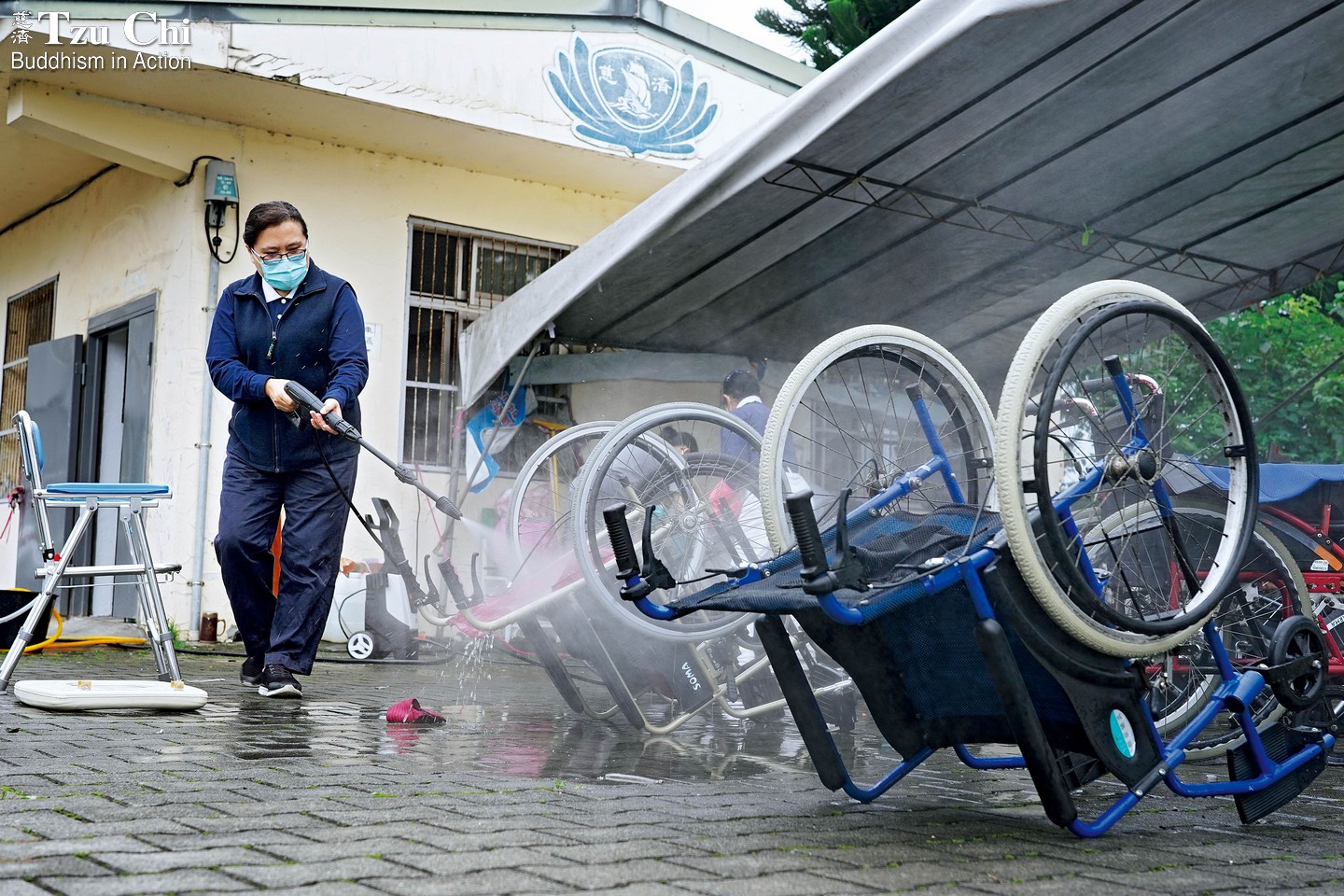
A volunteer washes wheelchairs with a pressure washer in an open space in front of the Yilan Jing Si Hall in Yilan, northeastern Taiwan.
How about parts?
Hong and his volunteering partners receive a wide variety of assistive devices, diverse in their type, mechanism, and functionality. How do the volunteers obtain the necessary parts when such a range of devices need to be repaired?
Hong led us into a small room in the old house to show us where he stores his supply of parts. He picked up a perfectly fine footplate he had removed from an unwanted wheelchair and explained, “Stripping still serviceable parts from beat-up assistive devices gives us enough parts to support our repair needs.”
The consumable parts of used devices, such as tires, must be replaced with brand-new components, but just about everything else—wheelchair footplates, toilet chair armrests, or even wheels, for example—can be replaced with reclaimed parts. Therefore, it’s not that difficult to obtain needed parts.
Huang Yu-ren (黃裕仁), one of Hong’s fellow volunteers, pointed out that a simple fix can save a lot of money. For example, a brand-new, adjustable bed costs at least 15,000 NT dollars (US$500), but a used, “broken” one at their repair shop may require nothing more than just tightening a loose screw. “Once repaired, it works fine, just like a new one,” he said.
“All of us in the Tzu Chi Eco-Friendly Assistive Device Program are required to follow the law,” Huang added. “Most devices may be repaired, but it is against the law to modify them.”
Huang recalled his first impression of Hong when he first started working with him. “This man is so obsessive!” he remembers thinking to himself. This was because after each repair was completed, Hong would test the device over and over again to ensure that nothing was amiss. But that was just Hong’s way of making sure that the next user received a high-quality, functional device.
In fact, Huang is just as “obsessive” as Hong when it comes to refurbishing an assistive device. For example, a repaired item sometimes has blemishes or other imperfections in its appearance, such as chipped paint. Though such imperfections do not lessen the functionality of the device, Huang can’t help feeling that the blemishes detract from its appeal. He therefore takes the time to repaint an item when necessary. “True, they’re used, but when they are thoroughly scrubbed and refurbished inside and out, their outward newness will please their new owners. Our attentiveness will warm the recipients’ hearts,” Huang said. In addition to beautifying recycled devices and helping with administrative work for the program, Huang also disinfects, cleans, repairs, and collects or delivers equipment.
Some volunteers don’t know how to fix things when they join Hong’s repair group, but Hong teaches them, starting from simple tasks. This is how he passes down his experience. “I initially didn’t know that there were so many types of wheelchairs,” he said, “that there were fixed and four-wheeled walkers, and that some electric beds had two motors and some had three.” The experience and knowledge he has accumulated benefits more people the more he shares it with others.
He pointed out that he and his fellow volunteers have accumulated so much experience because they’ve collected, repaired, and delivered device after device, worked with one recipient family after another, and exchanged their knowledge with that of repair volunteers in other places.
Some areas in southern Taiwan, such as Tainan and Kaohsiung, have yet to join the program and establish their own service outlets. Therefore, when people in those regions need Tzu Chi’s assistive device service, Huang and his fellow volunteers, based in Nantou, central Taiwan, step up to provide it.
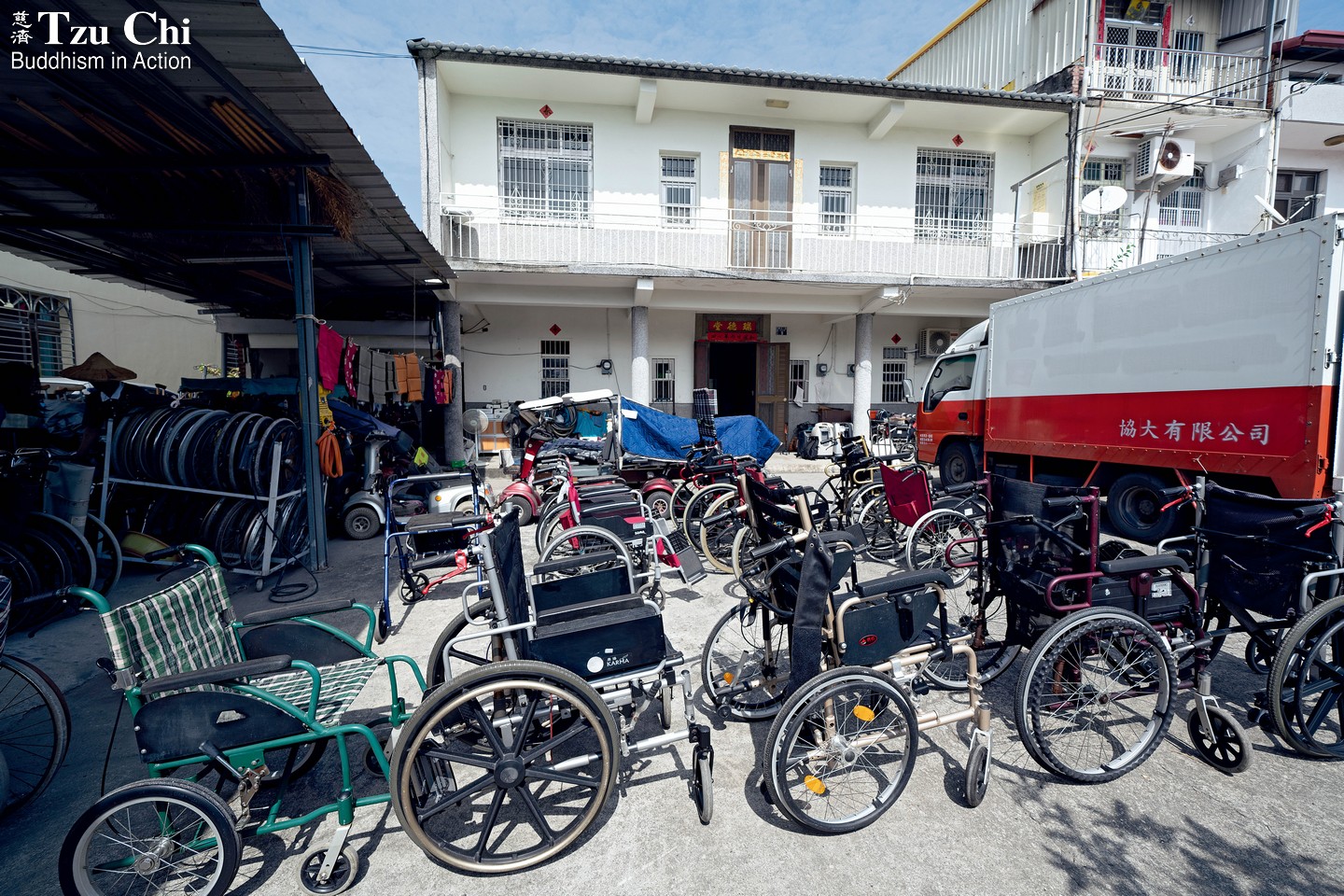
Assistive devices that have been disinfected with alcohol are sun-dried in a courtyard in an old house in Caotun, central Taiwan.
Volunteers scrub dismantled parts of toilet chairs. Every reclaimed piece of equipment under Tzu Chi’s assistive device program goes through four essential steps before it is put to use again: initial disinfection, cleaning, repair, and a second disinfection.
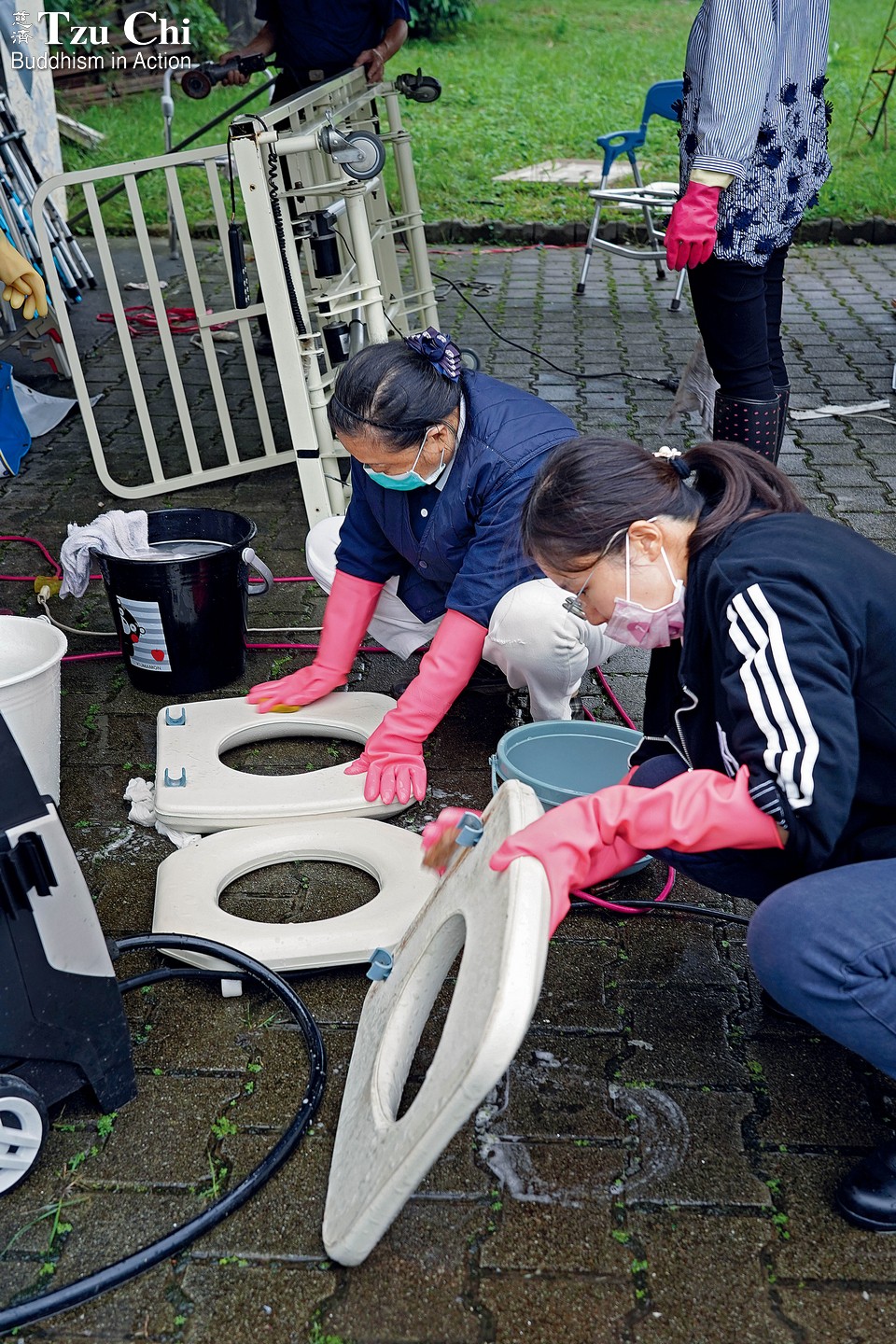
The devil is in the details
Volunteers in Yilan, northeastern Taiwan, have also joined the assistive device program and set up a service outlet there. Their outlet was launched in August 2020, not such a long time ago, but they’ve done enough work to leave local residents with a good impression of their service. It’s not just Tzu Chi donating members or care recipients that request their service, but the general public too.
Volunteer Liao Qi-cheng (廖啟丞), of the Yilan outlet, explained that they have been able to get up and running in such a short time mainly because volunteers in other areas have selflessly provided support and training.
The reclamation of used assistive devices involves four essential steps: initial disinfection, cleaning, repair, and a second disinfection. Only after a piece of equipment has gone through these steps will it go into inventory before being delivered to an applicant.
These four steps may seem easy at first glance, but there is more to them than meets the eye. This is because the equipment comes in different types, models, and sizes. How do you properly disassemble and clean a piece? How do you disinfect it thoroughly? How do you make sure all parts are safe to use and the device is working properly? There are many details to pay attention to, each one different for each type and model and size of device.
Volunteers in the Yilan service outlet gather every Tuesday afternoon to clean equipment. It rains just about every day in Yilan in winter, so volunteers have set up two canopies in an open space in front of the local Tzu Chi Jing Si Hall under which to work. The canopies sit right next to the outlet’s warehouse for recycled assistive devices.
On a typical Tuesday afternoon, volunteers were bustling about underneath and around the canopies as they carefully navigated the portable toilet chairs, wheelchairs, electric beds, and other items lying on the ground. The equipment had either been salvaged from Tzu Chi recycling stations or was donated by the public or nursing care centers. Most of the items were in good shape; only a few were a little stained or had a few rusty spots.
“We didn’t know the first thing about how to handle these things at first,” said volunteer Yang Mi (楊蜜). Members of the cleaning team are mostly recycling volunteers. Before the Yilan outlet was established, used assistive devices brought to local recycling stations by community residents were simply put aside in corners, unprocessed, waiting for people who needed them to take them away. But now things are different.
Thanks to the training provided by their counterparts in northern Taiwan, volunteers in Yilan have now gotten quite good at cleaning up assistive equipment. “A used toilet chair becomes like new after we’ve thoroughly scrubbed it down,” another volunteer piped up. They have even learned how to grind rust off a hospital bed and apply new layers of paint.
On this afternoon, as volunteers worked together to clean the equipment, some carefully sanitized and cleaned the devices lying on the ground with diluted bleach and pressure washers while others checked the gear for missing or defective parts. If a device was working fine after all surface blemishes were removed, it was put in storage. If not, it was routed to the repair team.
Volunteer Liao Qi-cheng coordinates the repair team, which consists of volunteers with expertise in machinery. They work in their spare time to fix things like electric beds or powered wheelchairs. Volunteers without such expertise can do some simple repairs, too. Under the tutelage of volunteers from other areas, for example, Yang Mi and her fellow cleaning volunteers have learned how to work in pairs to change a tire on a wheelchair.
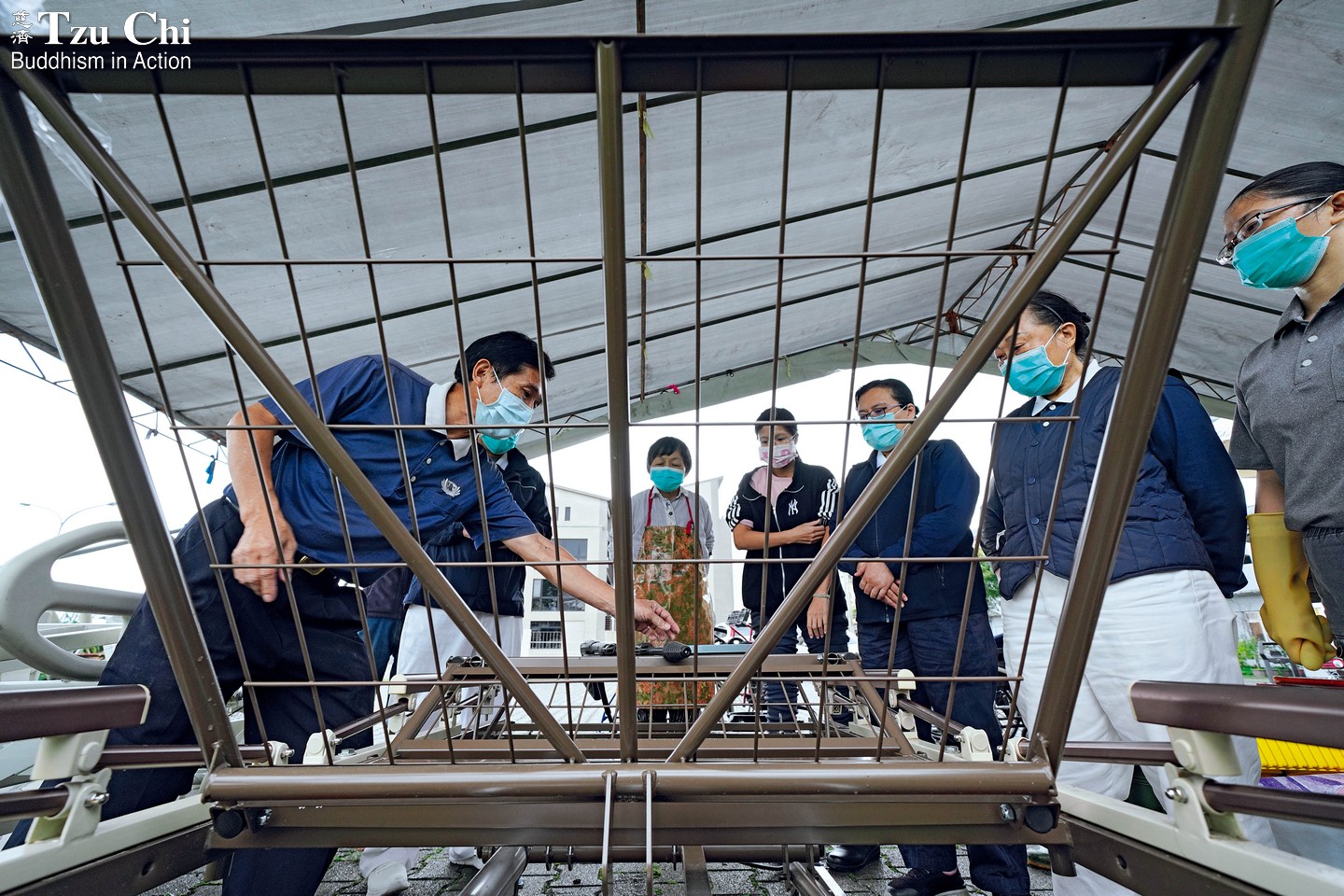
Volunteer Xie Guo-rong, from New Taipei City, northern Taiwan, teaches volunteers in Yilan how to repair and clean assistive devices. Such sharing of experiences allows volunteers to get up to speed sooner.
Safety first
Two pickup trucks were parked at the Bade Jing Si Hall in Taoyuan, northern Taiwan, while volunteers examined an air mattress and a wheelchair that were about to be shipped out. “We double-check one final time before sending anything out,” one of the volunteers said.
The Jing Si Hall, inaugurated just a few months before in November 2020, is home to the storage space for the Bade assistive device outlet. An indoor and an outdoor space respectively house equipment that is either “customer ready” or “to be worked on.”
Volunteer Zeng Qing-an (曾慶安), of the Bade outlet, explained that the Bade Jing Si Hall is equipped with a rainwater recycling system. Taking advantage of this system, volunteers first clean assistive devices with rainwater before rinsing them with clean water and sanitizing them. They want to prepare the devices to help others, but they strive to accomplish that objective without wasting any resources. Eco-friendliness, in line with the program’s spirit, is honored every step of the way.
Volunteer Peng Zhen-wei pointed out why every assistive device outlet attaches so much importance to cleaning and disinfecting: it’s tightly linked to the prevention of infections.
Scabies mites, for example, are one of the toughest pests that can be found in reclaimed assistive devices. After leaving the human body, a scabies mite can survive for three to four days at room temperature. Assistive equipment that is in intimate contact with the human body could be a medium through which the pests could spread.
Regardless of the outward appearance of a recycled assistive device, it must therefore be thoroughly and completely cleaned and sanitized to kill the germs or pests that may be present to make the gear safe for the next recipient. For the same hygienic reasons, every time volunteers take back a piece of equipment which is no longer needed, they make sure to spray it with disinfectant alcohol before loading it onto their truck.
The Tzu Chi Foundation has provided high-pressure water sprayers to all service outlets and begun purchasing ultraviolet disinfection equipment to help program volunteers clean and sanitize the assistive devices. Although the assistive devices provided by the program are not brand-new, the equipment looks as good as new after volunteers’ mindful cleaning and revamping work. The care with which they go about their work is heartwarming.
More than a dozen assistive device outlets have been established across Taiwan over the past four years. Volunteer Ye Yi-ben (葉義本), of the Xizhi outlet, said that before the program was launched, he often saw unwanted assistive devices showing up at Tzu Chi recycling stations. He had no way of knowing what he could do with those devices. Now with the program in place, he has finally been able to learn from other volunteers how to repair such items to extend their useful lives and at the same time help improve the environment. “It’s a truly wonderful thing,” he said.
Through their hard work, volunteers give each recycled device new life. Each piece of equipment they send out includes their best wishes for its new owner.
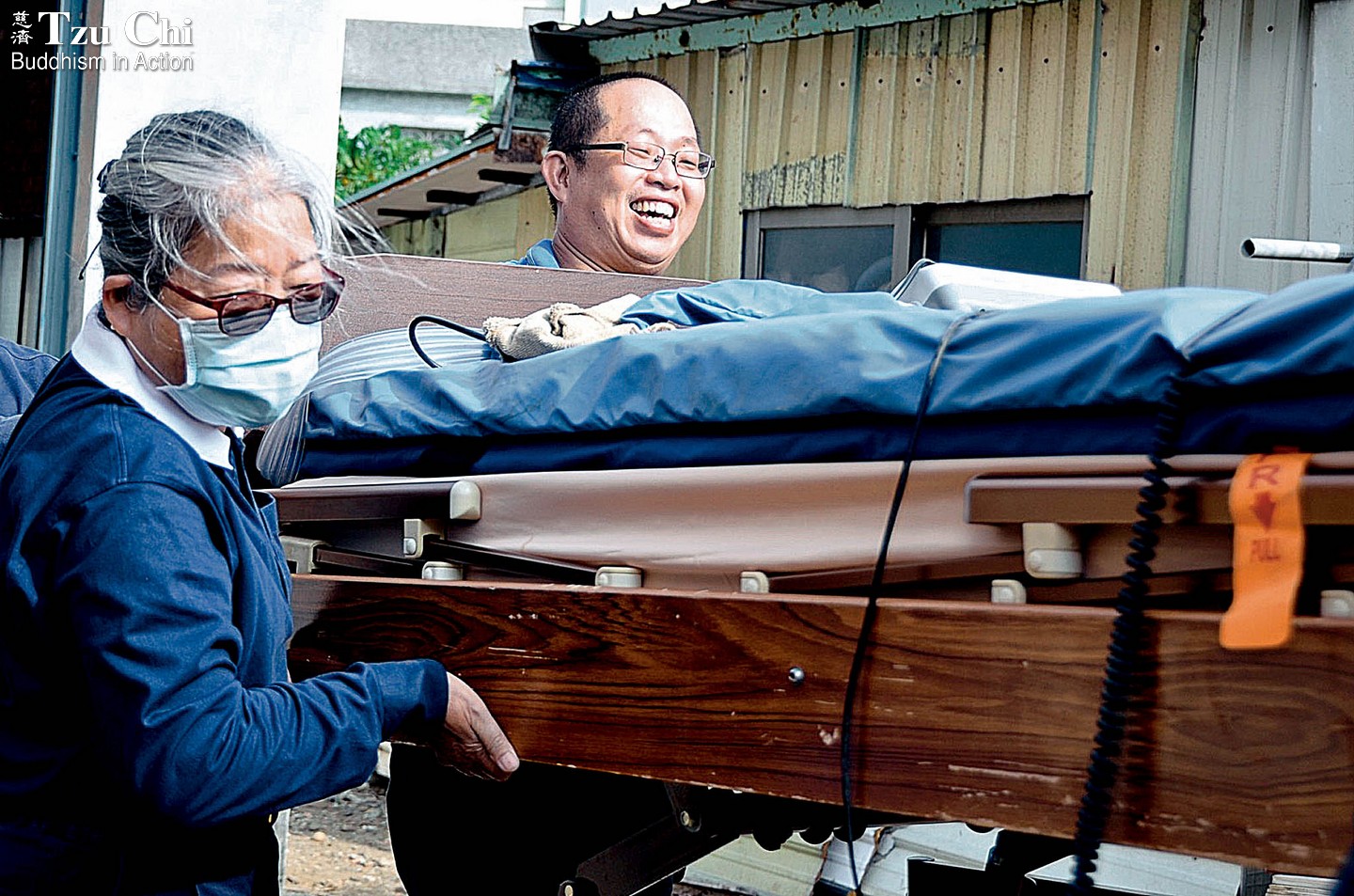
Volunteers for the Hsinchu assistive device outlet load an electric hospital bed and an air mattress onto a truck for delivery to a recipient. Li Shu-zhen

